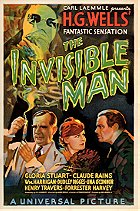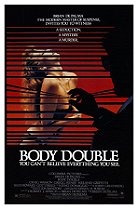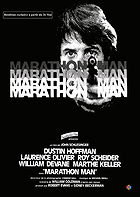All reviews -
Movies (55)
The Invisible Man review
 Posted : 6 years, 4 months ago on 18 February 2019 06:12
(A review of The Invisible Man)
Posted : 6 years, 4 months ago on 18 February 2019 06:12
(A review of The Invisible Man)A remarkable cinematic achievement rightfully categorised as a horror classic, albeit with a discernible, measured thread of comic verve and goofy humour. Demonstrating groundbreaking visual effects and showcasing an even stranger and amoral antagonist than Frankenstein's monster, the story addresses the folly of man in terms of harnessing intellectual dominion and notoriety through scientific achievement. A document of its time that continues to attract contemporary viewership on the basis of its suspenseful, perfectly condensed examination of a scientist driven mad in the pursuit of power and recognition for his perceived genius, so much so that he is prepared to transform himself into a monster. "The Invisible Man" is a scintillating and superlative standout in the revered canon of Universal horror during the 1930s.
 0 comments, Reply to this entry
0 comments, Reply to this entry
Body Double review
 Posted : 6 years, 4 months ago on 17 February 2019 07:37
(A review of Body Double)
Posted : 6 years, 4 months ago on 17 February 2019 07:37
(A review of Body Double)Voyeurism, fetishism and pornography collide in a frenzied, unabashedly psychosexual pastiche of "Vertigo" and "Rear Window". Whilst De Palma foregrounding of 1980s culture adds a new dimension of outre trashiness to the proceedings, the film exists on its own plane as an artefact of its time, albeit by translating images and styles as a register on what separates the contemporary from the past in terms of sex and murder. Although commenting on Hitchcock's erotic themes and De Palma's clear evocation of them is a thorny subject considering the latter's high art valuation by critics, "Body Double" is nevertheless a stylish, unsettling remnant of Hitchcockian imagery and psychological bent as viewed through the fervid sheen and perversions of Hollywood.
 0 comments, Reply to this entry
0 comments, Reply to this entry
Assault on Precinct 13 review
 Posted : 6 years, 4 months ago on 13 February 2019 06:19
(A review of Assault on Precinct 13)
Posted : 6 years, 4 months ago on 13 February 2019 06:19
(A review of Assault on Precinct 13)Aside from the slow-paced exposition built during the first thirty minutes, an armed gang and a prison van converge at the titular police precinct, enabling the nail-biting action to unfold at a sustained yet breakneck pace. With grimy indoor and outdoor scenery, suspense-driven interplay and ever-looming threat elevating the dark atmosphere, the film's taut plot resembles the "outnumbered siege" structure of "Rio Bravo" and "Night of the Living Dead", albeit with outgunned vengeful gangs in place of mindless zombies, however, an effective synthesizer score enhances the unsettling mood of the film into near-horror territory.
 0 comments, Reply to this entry
0 comments, Reply to this entry
Marathon Man (1976) review
 Posted : 6 years, 4 months ago on 5 February 2019 08:05
(A review of Marathon Man (1976))
Posted : 6 years, 4 months ago on 5 February 2019 08:05
(A review of Marathon Man (1976))When Thomas Babington Levy's secret agent brother is murdered before his eyes, he becomes embroiled in a plot involving smuggled diamonds and Nazi war criminal, former SS dentist Szell, the White Angel of Auschwitz.
The only movie to truly deliver the visceral power of a dental drill, John Schlesinger’s taut, well written if far-fetched and baffling thriller, is the film that gives you tooth ache in a good way. “Is it safe?” Those words fire a Pavlovian shock of pain through the upper molars for anyone who has taken in the film, an empathetic response to former Nazi Laurence Olivier drilling away inside Dustin Hoffman’s innocent mouth, while asking that obscure question. He’s after info, a clearance to sell his ill-gotten diamonds (stolen from Jews during the war), but Hoffman’s luckless Babe has no idea what he’s on about.
It’s a moment of icy genius, a starburst of cinema’s knee-jerk powers that almost overpowers all the knitted paranoia of the rest of the movie. William Goldman, a sharp clean screenwriter, sprawls about in unusually complicated fashion — here is a tale of a CIA black ops organisation called The Division who have dipped dirty fingers on all sides, including housing former Nazis, and the clean brother of one doomed operative who doesn’t possess the vital secret everyone thinks he does.
The title refers to Babe’s compulsion to run, something that will end up serving him in good stead. Hoffman threw himself into the part with familiar zeal, you half expect he required Olivier to actually drill his teeth. Oliver’s immortal response to the Method madness going on — “Why not try acting? It’s much easier” — harks from this very shoot, although there is the air of the apocryphal about the story. The ease with which Olivier transforms into this chilling refuge from the swollen evil of the past grants the film a resonance beyond its basic trappings. In real terms, there is nothing more than the motorised scheming of Goldman’s script and John Schlesinger’s up-close style going on, but his actors give its stretched ideas a seriousness and shock value, beyond putting your teeth on edge.
The only movie to truly deliver the visceral power of a dental drill, John Schlesinger’s taut, well written if far-fetched and baffling thriller, is the film that gives you tooth ache in a good way. “Is it safe?” Those words fire a Pavlovian shock of pain through the upper molars for anyone who has taken in the film, an empathetic response to former Nazi Laurence Olivier drilling away inside Dustin Hoffman’s innocent mouth, while asking that obscure question. He’s after info, a clearance to sell his ill-gotten diamonds (stolen from Jews during the war), but Hoffman’s luckless Babe has no idea what he’s on about.
It’s a moment of icy genius, a starburst of cinema’s knee-jerk powers that almost overpowers all the knitted paranoia of the rest of the movie. William Goldman, a sharp clean screenwriter, sprawls about in unusually complicated fashion — here is a tale of a CIA black ops organisation called The Division who have dipped dirty fingers on all sides, including housing former Nazis, and the clean brother of one doomed operative who doesn’t possess the vital secret everyone thinks he does.
The title refers to Babe’s compulsion to run, something that will end up serving him in good stead. Hoffman threw himself into the part with familiar zeal, you half expect he required Olivier to actually drill his teeth. Oliver’s immortal response to the Method madness going on — “Why not try acting? It’s much easier” — harks from this very shoot, although there is the air of the apocryphal about the story. The ease with which Olivier transforms into this chilling refuge from the swollen evil of the past grants the film a resonance beyond its basic trappings. In real terms, there is nothing more than the motorised scheming of Goldman’s script and John Schlesinger’s up-close style going on, but his actors give its stretched ideas a seriousness and shock value, beyond putting your teeth on edge.
 0 comments, Reply to this entry
0 comments, Reply to this entry
Suspiria review
 Posted : 6 years, 4 months ago on 4 February 2019 07:15
(A review of Suspiria)
Posted : 6 years, 4 months ago on 4 February 2019 07:15
(A review of Suspiria)The eternal hope is that when someone decides to remake a movie, they choose material that didn’t work before, giving the production room for improvement as it searches for reinterpretation. 1977’s “Suspiria” is a horror masterpiece, emerging from the demented depths of co-writer/director Dario Argento, who took the premise of an innocent coming into contact with pure evil and twisted it into a Technicolor freak-out, creating a thunderous achievement in sight and sound, also developing his interest in abstract areas of the occult. Screenwriter David Kajganich and director Luca Guadagnino have decided to return to Argento’s original picture for an update, and while they deserve some credit for trying to keep their feature as far away from the original as possible, this obsession to do something different results in a self-conscious, overwrought film that runs nearly twice as long as Argento’s endeavour.
The year is 1977, and Susie (Dakota Johnson) has moved from Ohio to Berlin to join the Markos Dance Academy, with hopes to impress the esteemed Madame Blanc (Tilda Swinton). The dancers are buzzing about the loss of colleague Patricia (Chloe Grace Moretz), who recently confessed to her psychotherapist, Josef (Swinton), her fears about the organization, declaring its run by a coven of witches. Susie focuses on her skills in the studio, making friends with Sara (Mia Goth), who’s growing unsure about her safety, while winning over Madame Blanc, taking control of the academy’s centrepiece performance, which requires complete submission to dramatic movement. Looking to investigate claims of witchcraft, Josef makes critical discoveries about the women who run the academy, while Susie gives herself to Madame Blanc, who senses something special about the young star during a time of preparation among the staff.
Guadagnino is currently riding a creative high, scoring critical and commercial hits with “A Bigger Splash” and “Call Me by Your Name.” He’s obviously a talented man with an intense appreciation for the value of cinematic form and experimentation, but “Suspiria” isn’t material that’s easily cracked open. Argento’s vision for hellraising at a ballet school was defiantly scattered, generating his own feel for narrative progression, which often involved shocking acts of violence, gloriously photographed to resemble a primary colored wonderland. The new “Suspiria” isn’t as brazen, with Guadagnino slowing down the velocity of the source material, reworking Susie’s experience in Berlin into multiple chapters charting her immersion into darkness. The screenplay has a lot of time to play with, and Kajganich tries to step beyond the original picture, providing a fuller meal of motivations for several characters while erasing most of the mystery, identifying Madame Blanc’s team as witches right away, steering the remake into a study of evil forces, not the concealment of them.
The new “Suspiria” is tirelessly artful, starting with the modern dance movement of the school, getting away from the fragility of Argento’s ballet to arrange hostile displays of bodily expression. Cinematography by Sayombhu Mukdeeprom is deliberately drained of color, questing to achieve a period look and remain a polar opposite viewing experience from the 1977 effort. The hostility of Berlin also plays an important part in the atmosphere of the movie, finding domestic terrorism and Nazi history adding unease to the tale, also permitting it more time outside the dance academy. The addition of Josef to the story offers some expanse that wasn’t there before, also introducing more of an investigative aspect to the overall haunting. And Susie isn’t the wide-eyed child sent to the slaughter, finding trauma from her past guiding her future (guilt drives most characterizations). There’s dramatic texture to give “Suspiria” substance and some narrative direction, but Guadagnino is easily distracted by superfluous additions, settling on a whopping 152 minute run time for his picture that’s entirely unwarranted. There’s nothing here that earns the length, keeping the helmer far too permissive with the final edit, giving into excess which often throttles potentially scarring scenes of discovery as a few of the dancers experience the full impact of the coven’s wrath.
“Suspiria” is grotesque, fixated on wetness and disease, with a droning score from Thom Yorke to keep it off-rhythm, fatiguing the effort. It’s dramatically limited, with Johnson unable to conjure screen authority as Susie, often fading into the background during any scene that doesn’t involve dancing, and Swinton’s dual role is more bewildering than necessary, with makeup achievements failing to pull off the old man illusion. Perhaps the greatest sin “Suspiria” commits is its lack of concentration, finding Guadagnino so intent on showing off what he can do with a challenging remake, he loses sight of the end game, finally going messy with witchery just to find closure, and even that is elusive. I recognize that some will be mesmerized by Guadagnino’s work here, but as a remake of a stone-cold classic, this “Suspiria” pales in comparison to the original. Argento managed to capture a widescreen nightmare in a distinctive, thrilling manner. Guadagnino turns cinematic fear into multiplex imprisonment.
The year is 1977, and Susie (Dakota Johnson) has moved from Ohio to Berlin to join the Markos Dance Academy, with hopes to impress the esteemed Madame Blanc (Tilda Swinton). The dancers are buzzing about the loss of colleague Patricia (Chloe Grace Moretz), who recently confessed to her psychotherapist, Josef (Swinton), her fears about the organization, declaring its run by a coven of witches. Susie focuses on her skills in the studio, making friends with Sara (Mia Goth), who’s growing unsure about her safety, while winning over Madame Blanc, taking control of the academy’s centrepiece performance, which requires complete submission to dramatic movement. Looking to investigate claims of witchcraft, Josef makes critical discoveries about the women who run the academy, while Susie gives herself to Madame Blanc, who senses something special about the young star during a time of preparation among the staff.
Guadagnino is currently riding a creative high, scoring critical and commercial hits with “A Bigger Splash” and “Call Me by Your Name.” He’s obviously a talented man with an intense appreciation for the value of cinematic form and experimentation, but “Suspiria” isn’t material that’s easily cracked open. Argento’s vision for hellraising at a ballet school was defiantly scattered, generating his own feel for narrative progression, which often involved shocking acts of violence, gloriously photographed to resemble a primary colored wonderland. The new “Suspiria” isn’t as brazen, with Guadagnino slowing down the velocity of the source material, reworking Susie’s experience in Berlin into multiple chapters charting her immersion into darkness. The screenplay has a lot of time to play with, and Kajganich tries to step beyond the original picture, providing a fuller meal of motivations for several characters while erasing most of the mystery, identifying Madame Blanc’s team as witches right away, steering the remake into a study of evil forces, not the concealment of them.
The new “Suspiria” is tirelessly artful, starting with the modern dance movement of the school, getting away from the fragility of Argento’s ballet to arrange hostile displays of bodily expression. Cinematography by Sayombhu Mukdeeprom is deliberately drained of color, questing to achieve a period look and remain a polar opposite viewing experience from the 1977 effort. The hostility of Berlin also plays an important part in the atmosphere of the movie, finding domestic terrorism and Nazi history adding unease to the tale, also permitting it more time outside the dance academy. The addition of Josef to the story offers some expanse that wasn’t there before, also introducing more of an investigative aspect to the overall haunting. And Susie isn’t the wide-eyed child sent to the slaughter, finding trauma from her past guiding her future (guilt drives most characterizations). There’s dramatic texture to give “Suspiria” substance and some narrative direction, but Guadagnino is easily distracted by superfluous additions, settling on a whopping 152 minute run time for his picture that’s entirely unwarranted. There’s nothing here that earns the length, keeping the helmer far too permissive with the final edit, giving into excess which often throttles potentially scarring scenes of discovery as a few of the dancers experience the full impact of the coven’s wrath.
“Suspiria” is grotesque, fixated on wetness and disease, with a droning score from Thom Yorke to keep it off-rhythm, fatiguing the effort. It’s dramatically limited, with Johnson unable to conjure screen authority as Susie, often fading into the background during any scene that doesn’t involve dancing, and Swinton’s dual role is more bewildering than necessary, with makeup achievements failing to pull off the old man illusion. Perhaps the greatest sin “Suspiria” commits is its lack of concentration, finding Guadagnino so intent on showing off what he can do with a challenging remake, he loses sight of the end game, finally going messy with witchery just to find closure, and even that is elusive. I recognize that some will be mesmerized by Guadagnino’s work here, but as a remake of a stone-cold classic, this “Suspiria” pales in comparison to the original. Argento managed to capture a widescreen nightmare in a distinctive, thrilling manner. Guadagnino turns cinematic fear into multiplex imprisonment.
 0 comments, Reply to this entry
0 comments, Reply to this entry
 Login
Login
 Home
Home 4 Lists
4 Lists 55 Reviews
55 Reviews Collections
Collections